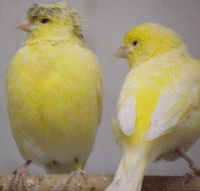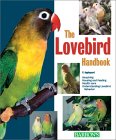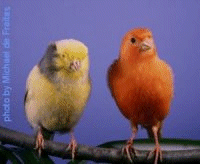Canaries
 Article by R.C. ‘Robirda’ McDonald
Article by R.C. ‘Robirda’ McDonald
Origin: The Canary Islands. These islands were named by the Romans, after the packs of wild dogs which roamed them. The birds were named after the islands centuries later, not the other way around, as many believe.
Family: Fringillidae (finches), Genus: Serinus, Species: Serinus serinus (European serin finch), Sub Species: Serinus canaria.
Types
Song Canaries: Perhaps the most famous canaries of all, these are bred strictly for their song. Most are yellow, green, or variegated. Best known are the Rollers, Waterslagers, American Singers, and Timbrados.
Type Canaries: These canaries are bred for their shape, stance, or some other physical characteristic. Some well-known type canary breeds are the Fife, Border, and Gloster canaries. Rarer are breeds like the Lizard, Yorkshire, Norwich, and Frilled (which is also seen in many varieties). While some can be fairly free-singing, little to no attention is paid to the style or quality of the song by most breeders.
Color Canaries: These canaries are bred for the colour of their feathers, and range from the yellow-and-green colours of the other breeds, to more esoteric shades of bronze, vermillian, silver, and pink, including almost every hue except true blues and solid black.
Bilbo (left) is a non-intensive Consort Gloster canary. He is the type of bird who is bred to the crested canaries to produce both crested and non-crested Glosters. The crest is a dominant mutation, and a crested canary should never be mated with another crested. Flame (right) is known as an intensive Red Lipochrome Colour Canary, also sometimes called simply ‘Clear Red’, or just ‘Red Factor’ – although this last is actually more of a generic term, and properly applies to all canaries capable of expressing red colour in their feathers. *Photo by Michael de Freitas
Unlike many species of birds commonly kept as pets, canaries are territorial rather than social. The song of the males, and, to some extent the hens as well, is used to announce their presence and their claim to their territory. They are not very social with others of their kind and will rarely if ever enjoy sharing a pet-style cage with another bird.
Cages: Canaries are flyers rather than climbers, and therefore require larger cages relative to their size than many of the hookbills. Round cages should never be used with any kind of flying bird the shape makes it difficult to place perches parallel to each other, and so restricts the birds, making it difficult for them to move naturally. Bar spacing can be as much as 5/8 of an inch for the larger canaries, but should be no more than 1/2 an inch for the smaller breeds.
Diet: Like most other cage-birds, the canary requires far more than just seed alone. A basic seed mix should consist of 75% canary grass, 15% canola rapeseed, and 10% mixed specialty seeds such as flax, hemp, niger, and teazle. As much as 50% of the diet can consist of fresh foods, especially greens in the cole families mixed with grated carrot. Feed ‘treats’ such as millet sprays and ‘song’ food mixes sparingly and infrequently – they are very fatty and can stress their livers and kidneys if given too frequently. Clean, fresh water must always be available. Due to their small bodies and high metabolic rate, a canary will die within 12-24 hours without it.
Health: Canaries are extremely sensitive to trace gases and other such toxins, so be careful to not use air fresheners, rug deodorizers, perfumes, and other such volatiles in their presence. For this reason, the kitchen is not a good place to keep them; fumes or smoke from cooking foods could make them ill. Every bird-owning household should beware of Teflon cookware as this emits gases that are highly toxic to birds if overheated. Moulting should occur once a year, just after midsummer. A moult at any other time of the year is usually caused by the presence of a (warm or cold) draft from which the bird has no shelter. It can also be associated with shock or illness. A pet canary will usually live an average of 10 years or so, given good care.
Noise: Some of the type canaries can sing loud, rather shrill songs, but they are the exception to the rule. In general, the canary is one of the sweetest-voiced birds on the planet. Song canaries are trained to sing in harmony with others of their kind, and their owners compete vigorously for the prestigious prizes awarded their proteges. You can find quiet-singing canaries (Rollers), moderate-singing canaries (Waterslagers and American Singers), and loud singers (Timbrados, Type, and Colour Canaries). Rarely will canary owners receive complaints about the noise of their birds, which makes them particularly ideal for apartment dwellers.
Sleep: Canaries are photosensitive, and therefore should be kept on a cycle similar to that followed by the sun outdoors, unless you live in the tropics or at a pole. Many people cover their bird at sunset, and then remove the covers just before they go to bed, after the lights are out. That way the birds will see a natural sunrise. Don’t allow their nights to be shorter than about 10 hours, or longer than 14 hours.
Sexual Behaviour: As the breeding season approaches, a hen will fly almost ceaselessly. She will begin to search for nesting material and trot about everywhere with beakfuls of it, looking for the best place to build her nest. When she is ready to mate, she will crouch low on the perch, with her head back a little and her tail lifted, and call the male with a soft, incessant twittering. She must be able to grasp the perch firmly, because she is the sole support for the two birds during mating.
The males will also become restless as the winter ends, and, if they come into full breeding condition early, may harass and chase the hens ceaselessly, stressing her beyond tolerance. For this reason it is best to cage the two separately but where they can see each other until the hen’s actions indicate she is ready. Many males will feed their intended bride (or, if she is not accessible, the corners of his feet, or any other v-shaped niche in his cage), visually producing the effect that the birds are kissing. Divided breeding cages take advantage of this by allowing the male to court and feed his hen through the wire, but restricting his ability to chase her. Once the hen has indicated she is ready the divider is removed and breeding season begins in earnest.
Breeding: Canaries are photosensitive, and are brought into breeding condition by, among other things, the lengthening days of spring. They will fight ferociously with any other birds caged with them at this time, unless it is a bird of the opposite sex who is also in good breeding condition. They require soft foods with a good level of protein to feed the babies, who grow to adult size in less than 3 weeks. Weaning to independence is usually accomplished in another three weeks or less. Be warned if you would like to try breeding these small complex little beauties – unlike most of the popular pet bird species, canaries are anything but easy to breed!
Do your research thoroughly and well before you even think of trying to breed canaries. This aspect of breeding canaries is the reason you will rarely see a canary priced similarly to, say, a budgie; if you do, you should probably suspect the seller of harboring an unspoken motivation! Canaries hold a unique status in the world of songbirds, the little birds with the uncommonly beautiful voices, irrespressible personalities, and a long history of confounding humans. Perhaps that is why so many of us find them so irresistable.










